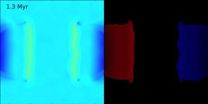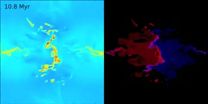(Press-News.org) One of the greatest challenges in modern medicine is developing drugs that are highly effective against a target, but with minimal toxicity and side-effects to the patient. Such properties are directly related to the 3D structure of the drug molecule. Ideally, the drug should have a shape that is perfectly complementary to a disease-causing target, so that it binds it with high specificity. Publishing in Nature Chemistry, EPFL scientists have developed a synthetic amino acid that can impact the 3D structure of bioactive peptides and enhance their potency.
Peptides and proteins as drugs
Many of the drugs we use today are essentially naturally-occurring peptides (small) and proteins (large), both of which are made up with the amino acids found in all living organisms. Despite the enormous variety of peptides and proteins, there are only twenty natural amino acids, each with a different structure and chemical properties. When strung together in a sequence, amino acids create peptides and proteins with different 3D structures and, consequently, different biological functions.
Until recently, the vast majority of amino acid-based drugs were the kinds occurring in nature: hormones such as insulin, antibiotics such as vancomycin, immunosuppressive drugs such as cyclosporine etc. But the mounting burden of diseases means that newer and more effective medications must be developed; for example, bacterial resistance is growing globally, pushing our need for novel antibiotics. One way to address this need is the cutting-edge field of directed evolution, which mimics natural selection in the lab to evolve and develop new peptides and proteins.
A new amino acid for new peptides
The team of Christian Heinis at EPFL has developed a synthetic amino acid whose unique structure can considerably increase the effectiveness of therapeutic peptides and proteins. The synthetic amino acid has a very similar structure to a natural amino acid called cysteine. Cysteine is unique among the twenty natural amino acids because it contains a sulfur group. This allows it to form a bridge with another cysteine, and thereby influence the overall 3D structure – and function – of a peptide or protein.
The EPFL researchers initially designed five cysteine-like amino acids, all with one crucial change: each one could form two bridges instead of just one. The team achieved this by replacing cysteine's single sulfur group with a branch containing two sulfur groups. After synthesizing the five new amino acids, the team integrated them into the structure of two bioactive peptides, one that inhibits an enzyme implicated in cancer, and one blocking a receptor found in neurons.
Testing only a handful of cyclic peptides with the synthetic amino acid, Heinis' team was able to identify several peptides that showed enhanced activities. The best inhibitor of the neuron receptor was 8-fold improved and the best protease inhibitor had even a 40-fold higher activity.
"This was unexpected", says Christian Heinis. "Usually when you tamper with a natural molecule, you end up making it worse. In this case, we found the exact opposite, which is very exciting."
The emerging class of bicyclic peptides
The team focuses on therapeutics, where they have a strong background in developing "bicyclic" peptides – peptides that contain two rings in their structure. Bicyclic peptides have grown into a new class of therapeutic peptides that can be used on disease target that conventional small molecules or large antibodies cannot reach. Heinis' group has generated bicyclic peptides against a range of disease targets using directed evolution. "In our work with bicyclic peptides, we learned that wide structural diversity in peptide libraries is key for achieving good binding. With this new amino acid, it is possible to produce highly diverse peptide structures."
Heinis aims now to use the new amino acid in directed evolution experiments. Its structural features and its ability to efficiently make cyclic peptides makes the synthetic amino acid a promising candidate for developing new, effective polycyclic peptides for targeted therapy.
INFORMATION:
Reference
Chen S. Gopalakrishnan R, Schaer T, Marger F, Hovius R, Bertrand D, Pojer F, Heinis C. Di-thiol amino acids can structurally shape and enhance the ligand-binding properties of polypeptides. Nature Chemistry 31 August 2014. DOI: 10.1038/nchem.2043
A new synthetic amino acid for an emerging class of drugs
2014-08-31
ELSE PRESS RELEASES FROM THIS DATE:
Discovery reveals how bacteria distinguish harmful vs. helpful viruses
2014-08-31
When they are not busy attacking us, germs go after each other. But when viruses invade bacteria, it doesn't always spell disaster for the infected microbes: Sometimes viruses actually carry helpful genes that a bacterium can harness to, say, expand its diet or better attack its own hosts.
Scientists have assumed the bacterial version of an immune system would robotically destroy anything it recognized as invading viral genes. However, new experiments at Rockefeller University have now revealed that one variety of the bacterial immune system known as the CRISPR-Cas system ...
Why sibling stars look alike: Early, fast mixing in star-birth clouds
2014-08-31
VIDEO:
This 11-second movie shows a computational simulation of a collision of two converging streams of interstellar gas, leading to collapse and formation of a star cluster at the center. Face-on...
Click here for more information.
Stars are made mostly of hydrogen and helium, but they also contain trace amounts of other elements, such as carbon, oxygen, iron, and even more exotic substances. By carefully measuring the wavelengths (colors) of light coming from a star, astronomers ...
Mixing in star-forming clouds explains why sibling stars look alike
2014-08-31
VIDEO:
This computer simulation shows the collision of two streams of interstellar gas, leading to gravitational collapse of the gas and the formation of a star cluster at the center. The...
Click here for more information.
The chemical uniformity of stars in the same cluster is the result of turbulent mixing in the clouds of gas where star formation occurs, according to a study by astrophysicists at the University of California, Santa Cruz. Their results, published August 31 in ...
Antarctic sea-level rising faster than global rate
2014-08-31
A new study of satellite data from the last 19 years reveals that fresh water from melting glaciers has caused the sea-level around the coast of Antarctica to rise by 2cm more than the global average of 6cm.
Researchers at the University of Southampton detected the rapid rise in sea-level by studying satellite scans of a region that spans more than a million square kilometres.
The melting of the Antarctic ice sheet and the thinning of floating ice shelves has contributed an excess of around 350 gigatonnes of freshwater to the surrounding ocean. This has led to a reduction ...
Changing global diets is vital to reducing climate change
2014-08-31
A new study, published today in Nature Climate Change, suggests that – if current trends continue – food production alone will reach, if not exceed, the global targets for total greenhouse gas (GHG) emissions in 2050.
The study's authors say we should all think carefully about the food we choose and its environmental impact. A shift to healthier diets across the world is just one of a number of actions that need to be taken to avoid dangerous climate change and ensure there is enough food for all.
As populations rise and global tastes shift towards meat-heavy Western ...
A new way to diagnose malaria
2014-08-31
CAMBRIDGE, MA -- Over the past several decades, malaria diagnosis has changed very little. After taking a blood sample from a patient, a technician smears the blood across a glass slide, stains it with a special dye, and looks under a microscope for the Plasmodium parasite, which causes the disease. This approach gives an accurate count of how many parasites are in the blood — an important measure of disease severity — but is not ideal because there is potential for human error.
A research team from the Singapore-MIT Alliance for Research and Technology (SMART) has now ...
Memory and Alzheimer's: Towards a better comprehension of the dynamic mechanisms
2014-08-31
This news release is available in French. Montréal, August 31, 2014 – A study just published in the prestigious Nature Neuroscience journal by, Sylvain Williams, PhD, and his team, of the Research Centre of the Douglas Mental Health University Institute and McGill University, opens the door towards better understanding of the neural circuitry and dynamic mechanisms controlling memory as well of the role of an essential element of the hippocampus – a sub-region named the subiculum.
In 2009, they developed a unique approach – namely, the in vitro preparation of a hippocampal ...
Renal denervation reduces recurrent AF after ablation
2014-08-31
Barcelona, Spain – Sunday 31 August 2014: Renal denervation reduces recurrent atrial fibrillation (AF) when performed with pulmonary vein isolation ablation in patients with AF and hypertension, according to research presented at ESC Congress today by Dr Alexander Romanov from the Russian Federation.
Dr Romanov said: "The prevalence of AF ranges from 1.5 to 2% in developed countries. This arrhythmia is associated with increased mortality, a five-fold risk of stroke and a 3-fold incidence of congestive heart failure. The vast majority of patients with AF also have arterial ...
Energy drinks cause heart problems
2014-08-31
Barcelona, Spain – Sunday 31 August 2014: Energy drinks can cause heart problems according to research presented at ESC Congress 2014 today by Professor Milou-Daniel Drici from France.
Professor Drici said: "So-called 'energy drinks' are popular in dance clubs and during physical exercise, with people sometimes consuming a number of drinks one after the other. This situation can lead to a number of adverse conditions including angina, cardiac arrhythmia (irregular heartbeat) and even sudden death."
He added: "Around 96% of these drinks contain caffeine, with a typical ...
Antihypertensive therapy reduces CV events, strokes and mortality in older adults
2014-08-31
Barcelona, Spain – Sunday 31 August 2014: Antihypertensive therapy reduces the risk of cardiovascular (CV) events, strokes and mortality in hypertensive older adults, according to research presented at ESC Congress 2014 today by Dr Maciej Ostrowski from Poland. The findings suggest that antihypertensive drugs should be considered in all patients over 65 years of age with hypertension.
Dr Ostrowski said: "Over the past few decades, a number of randomised trials and meta‑analyses have supported the benefits of antihypertensive medication in reducing the incidence ...





